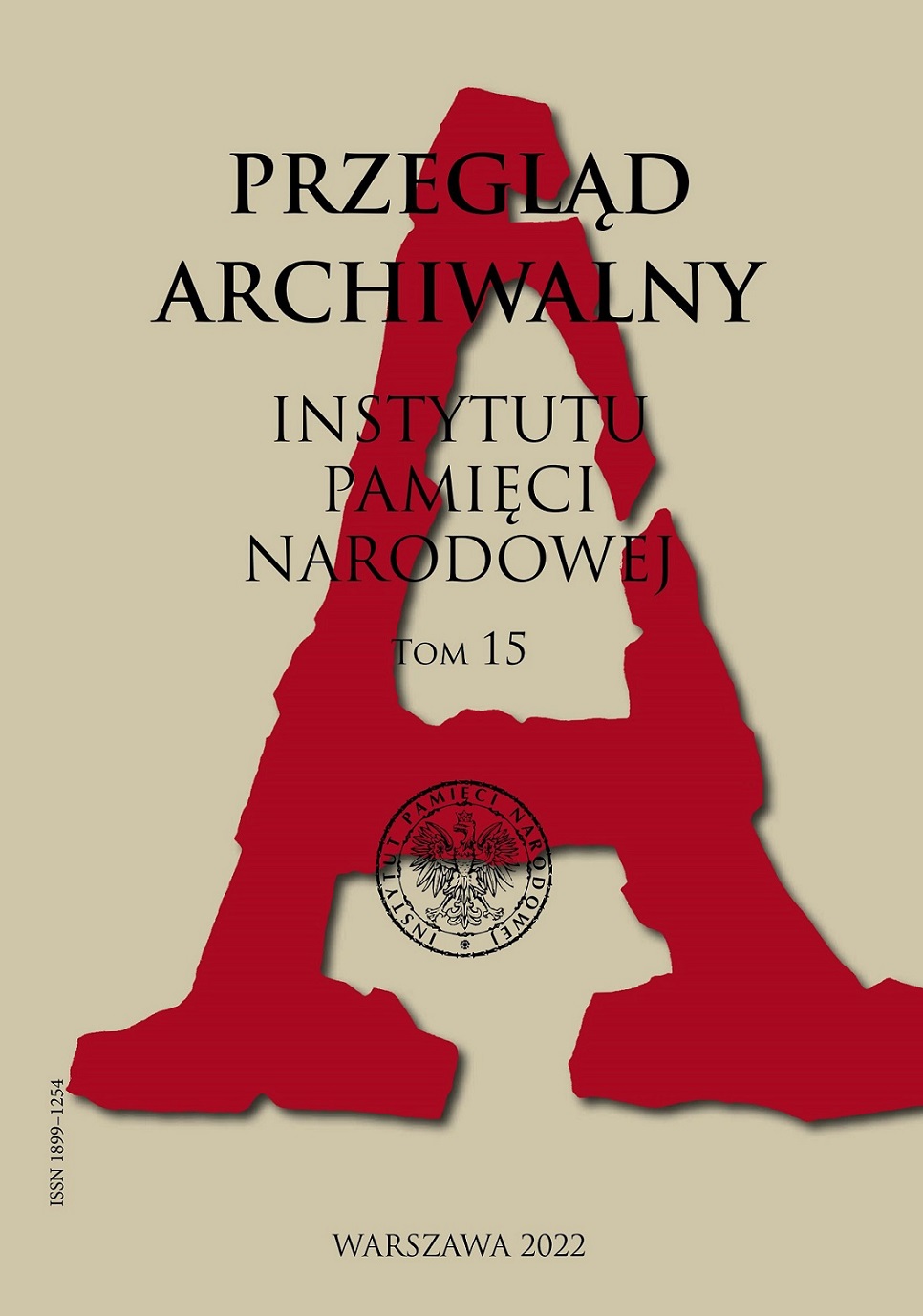Od pomnika z dokumentów do cyfrowego upamiętnienia. Historia Archiwum Arolsen 1945–2020
Przegląd Archiwalny Instytutu Pamięci Narodowej, Nr 15 (2022), strony: 167–182
Data publikacji: 2022-12-30
 https://doi.org/10.48261/PAIPN221508
https://doi.org/10.48261/PAIPN221508
Abstrakt
Arolsen Archives przechowuje największy na świecie zbiór dokumentów dotyczących ofiar i ocalałych z nazistowskich prześladowań. Niniejszy tekst dotyczy dziejów tej wyjątkowej organizacji, znanej do 2019 r. jako International Tracing Service (ITS). Artykuł skupia się na czterech aspektach. Po pierwsze, zawiera opis historii poszukiwań i dokumentowania ofiar niemieckiego nazizmu do początku lat pięćdziesiątych XX w. U podstaw tego coraz bardziej scentralizowanego procesu leżało utworzenie przez aliantów ITS. Druga część skupia się na różnych metodach poszukiwania oraz na tym, jak z upływem czasu zmieniały się potrzeby ocalałych i krewnych w zakresie informacji. Trzecia część poświęcona jest temu, jak w procesie poszukiwania i dokumentowania ofiar nazizmu powstawała i kształtowała się unikatowa kolekcja archiwalna. Na koniec przedstawiono zagadnienie formowania się relacji między ITS a społeczeństwem w odniesieniu do zasadniczego pytania o dostępność archiwum dla badań naukowych i inicjatyw związanych z pamięcią. Omówiono, w jaki sposób z pierwotnie zamkniętego serwisu poszukiwawczego powstało otwarte i cyfrowe centrum informacji o nazistowskich prześladowaniach.
Słowa kluczowe
prześladowania nazistowskie • Holokaust • Międzynarodowa Służba Poszukiwawcza • Arolsen Archives • dokumenty • ITS • International Tracing Service • International Tracing Service (ITS) Nazi persecution • Holocaust • International Tracing Service (ITS) • International Tracing Service • ITS • Arolsen Archives • documents
Bibliografia
Abkommen über die Errichtung eines Internationalen Ausschusses für den Internationalen Suchdienst, Bundesanzeiger, 7, 241, 14 XII 1955.
Archiwum NDR w Hamburgu: F834411012.
Arolsen Archives: 6.1.1/82500734/ITS Digital Archive; 6.1.1/82505800/ITS Digital Collection; 6.1.1/82507305/ITS Digital Archive; 6.1.1/82508414/ITS Digital Archive; 11.4/4595/ITS Archive; 11.5/4562/ITS Archive; 12.2.17.1/159/ITS Archive.
Böhme K.W., Gesucht wird… Die dramatische Geschichte des Suchdienstes, Munich 1965.
Borggräfe H., Höschler Ch., Panek I., A Paper Monument: Introduction [w:] A Paper Monument: The History of the Arolsen Archives, red. H. Borggräfe, Ch. Höschler, I. Panek, Bad Arolsen 2019.
Borggräfe H., Leßau H., Die Wahrnehmung der NS-Verbrechen und der Umgang mit den NS-Verfolgten im International Tracing Service [w:] Die Wahrnehmung der NS-Verbrechen und ihrer Opfer im Wandel, red. H. Borggräfe, H. Leßau, H. Schmid, Göttingen 2015.
Borggräfe H., Panek I., Collections Archives Dealing with Nazi Victims [w:] Tracing and Documenting Nazi Victims Past and Present, red. H. Borggräfe, Ch. Höschler, I. Panek, Munich 2020.
Bräu R., Hofmann K., Meier-Osiński A., The New Tasks and Challenges for Tracing [w:] Tracing and Documenting Nazi Victims Past and Present, red. H. Borggräfe, Ch. Höschler, I. Panek, Munich 2020.
Catalogue of Concentration Camp Records held by the International Tracing Service of the Allied High Commission for Germany, t. I–II, Arolsen 1951.
Djurović G., The Central Tracing Agency of the International Committee of the Red Cross, Geneva 1986.
Edkins J., Missing: Persons and Politics, Ithaca 2016.
Inicjatywa #everynamecounts, https://arolsen-archives.org/en/learn-participate/exhibitions-ca3mpaigns/everynamecounts/ (dostęp 9 IX 2022 r.).
International Refugee Organization: Historical Survey of Central Tracing Activity in Germany, 1945–1951, The Tracing of Missing Persons in Germany on an International Scale with Particular Reference to the Problem of U.N.R.R.A., Geneva 1951.
ITS, Annual Report for the Year 1976, Arolsen 1976.
ITS, Catalogue of Camps and Prisons in Germany and German-occupied Territories Sept. 1st, 1939 – May 8th, 1945, Arolsen 1949.
ITS, Inclusion of the Archives on the UNESCO World Document Heritage List, Annual Report 2013, Bad Arolsen 2013, https://arolsen-archives.org/content/uploads/its_jahresbericht_2013.pdf (dostęp 22 IV 2022 r.).
ITS, Verzeichnis der Haftstätten unter dem Reichsführer SS (1933–1945), Arolsen 1979.
Internetowe Archiwum Arolsen, https://collections.arolsen-archives.org/en/search/ (dostęp 9 IX 2022 r.).
Levi L.G., Family Searching and Tracing Services of JDC in the Second World War Era [w:] Tracing and Documenting Nazi Victims Past and Present, red. H. Borggräfe, Ch. Höschler, I. Panek, Munich 2020.
Ossenberg U., The Document Holdings of the International Tracing Service: Using the Digital Archives in the Context of their Creation and Evolution. A Guideline, Bad Arolsen 2009.
Panek I., Between Waiting and New Beginnings: Displaced Persons in Arolsen [w:] Two Kinds of Searches – Findings on Displaced Persons in Arolsen after 1945, red. Ch. Höschler, I. Panek, Bad Arolsen 2019.
Perspectives fot the ITS. Annual Report 2012, Bad Arolsen.
Reus J., „Everywhere where human beings are, we can find our children”. On the Organization of the ITS Child Search Branch Files [w:] Freilegungen: Rebuilding Lives – Child Survivors and DP Children in the Aftermath of the Holocaust and Forced Labor, red. H. Borggräfe, A. Jah, S. Jost, N. Ritz, Göttingen 2016.
Rodgers J., „From the «Archive of Horrors» to the «Shop Window of Democracy»: The International Tracing Service and the Transatlantic Politics of the Past”, praca doktorska, Uniwersytet Pensylwanii, Filadelfia 2014.
Schönemann S., Das Namensregister als Zeugnis: Zur kommemorativen Funktion früher Überlebenden-Suchdienste [w:] R. Boehling, S. Urban, R. Bienert, Freilegungen: Überlebende – Erinnerungen – Transformationen, Göttingen 2013.
Schönemann S., Die Untersuchungstätigkeit des International Tracing Service zu Todesmärschen. Das Programm „Attempted Identification of Unknown Dead”, „Gedenkstättenrundbrief” 2011, nr 159.
Shapiro P.A., Bad Arolsen – Die Öffnung des größten Holocaust-Archivs der Welt, https://www.youtube.com/watch?v=cf-jfkh1lss (dostęp 22 IV 2022 r.).
The International Prisoners-of-War Agency: The ICRC in World War One, International Committee of the Red Cross, Geneva 2017.
Urban S., „Mein einziges Dokument ist die Nummer auf der Hand…”. Aussagen Überlebender der NS-Verfolgung im International Tracing Service, Berlin 2018.
Zimmer B.J., International Tracing Service Arolsen: Von der Vermisstensuche zur Haftbescheinigung. Die Organisationsgeschichte eines „ungewollten Kindes” während der Besatzungszeit, Bad Arolsen 2011.
 Język Polski
Język Polski
 English
English



 PDF
PDF
